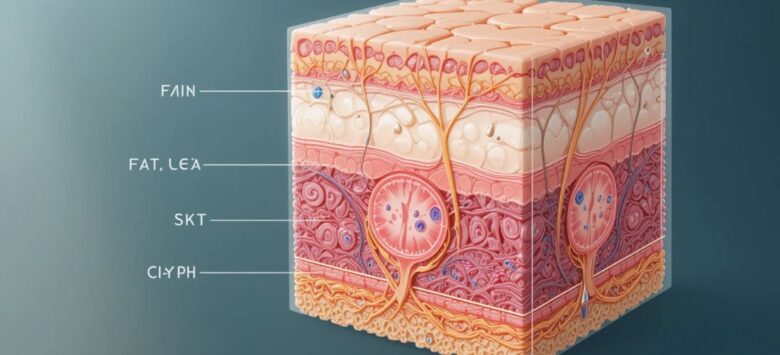Cellulite is a term that many are familiar with, but understanding the scientific processes behind its formation requires a closer look at the skin’s structure, connective tissues, and fat cells. In this article, we’ll break down the science of cellulite formation, explaining how it develops and what factors influence its appearance.
Understanding the Structure of the Skin
To understand cellulite, it’s essential to know how the skin is structured. The skin consists of three main layers:
- Epidermis: The outermost layer that acts as a protective barrier.
- Dermis: The middle layer that contains connective tissue, blood vessels, and hair follicles.
- Subcutaneous Fat Layer: The deepest layer that stores fat cells, which are important for energy storage and insulation.
Cellulite forms in the subcutaneous fat layer, where fat cells interact with the connective tissue, leading to the characteristic dimpled appearance.
The Role of Connective Tissue
The connective tissue in the dermis, composed of collagen and elastin fibers, serves as a framework that supports the skin and separates fat cells. In areas prone to cellulite:
- The connective tissue forms vertical bands that anchor the skin to the underlying muscle.
- Fat cells push against these bands, causing the skin to bulge between the connective tissue, resulting in dimples and lumps.
Women are more likely to experience cellulite than men due to differences in how connective tissue is structured. In women, the connective tissue bands run vertically, making the skin more susceptible to dimpling. In men, these bands form a crisscross pattern, which provides more structural support.
Factors That Influence Cellulite Formation
Several factors contribute to the formation of cellulite, including:
1. Hormones
Hormones such as estrogen, insulin, and noradrenaline play a critical role in regulating fat storage and connective tissue health. Estrogen, in particular, is thought to weaken collagen fibers and increase fat storage in specific areas, such as the thighs and hips.
2. Genetics
Genetic predisposition affects skin thickness, fat distribution, and connective tissue strength. If your family has a history of cellulite, you may be more prone to developing it.
3. Lifestyle
- Diet: A diet high in processed foods and sugars can lead to fat accumulation and poor skin health.
- Exercise: Lack of physical activity can reduce muscle tone, making cellulite more noticeable.
- Hydration: Dehydration weakens the skin’s elasticity, exacerbating the appearance of cellulite.
4. Aging
As we age, collagen production decreases, and skin elasticity diminishes. This weakening of the skin and connective tissue makes cellulite more visible over time.
5. Circulation
Poor blood flow can affect the removal of waste and toxins from the body, potentially worsening the appearance of cellulite. Reduced circulation can also limit the delivery of oxygen and nutrients to the skin and connective tissues.
Why Does Cellulite Appear in Specific Areas?
Cellulite is most commonly found on the thighs, hips, buttocks, and abdomen. These areas are prone to fat storage due to hormonal regulation and are more susceptible to the structural changes that lead to cellulite.
Interestingly, the distribution of cellulite-prone areas can vary based on gender, genetics, and body type. Women tend to store fat in their lower bodies, while men often accumulate fat in the abdomen.
Advances in Understanding Cellulite
Recent scientific studies have deepened our understanding of cellulite. Here are a few insights:
- Microcirculation: Research suggests that reduced microcirculation (small blood vessel flow) in cellulite-prone areas may play a role in its formation.
- Fibrosis: In advanced stages of cellulite, the connective tissue bands may become fibrotic (thicker and less flexible), worsening the dimpling effect.
- Fat Cell Hypertrophy: Enlargement of fat cells in the subcutaneous layer can amplify the pressure on connective tissues, making cellulite more pronounced.
Can Science Help Reduce Cellulite?
While science has provided valuable insights into the formation of cellulite, it has also guided the development of various treatments. Some evidence-based methods include:
- Laser and Radiofrequency Treatments: These technologies stimulate collagen production, improve circulation, and reduce fat cell size.
- Topical Treatments: Products containing caffeine or retinol can temporarily improve skin texture by enhancing circulation and promoting collagen production.
- Exercise and Diet: Strength training and cardiovascular exercises help build muscle tone and reduce fat stores, minimizing the appearance of cellulite.
Conclusion
Cellulite formation is a complex interplay of fat cells, connective tissue, hormones, and lifestyle factors. While it’s not a health concern, understanding its science can empower you to manage its appearance effectively. Remember, cellulite is a natural and common part of the human body, affecting individuals of all shapes and sizes.
The next time you look in the mirror, appreciate your body for all it does rather than focusing on imperfections. Science reminds us that cellulite is not a flaw but simply a result of our unique anatomy.
Have thoughts or questions? Join the conversation in the comments!




